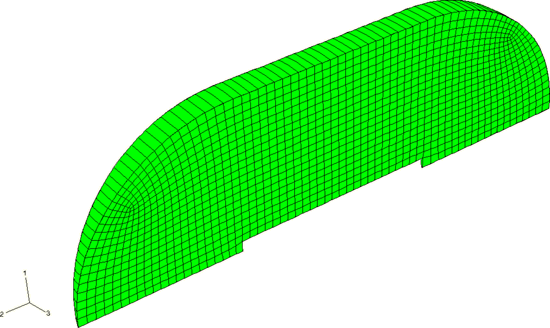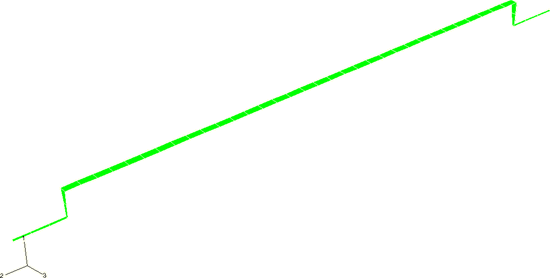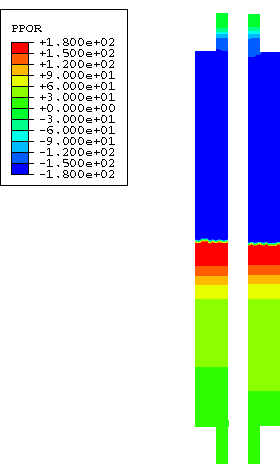The system considered here consists of a cylindrical muffler and the
interacting air. The muffler is a simple tube 180 mm in diameter and 1 m in
length, with inlet and outlet pipes 70 mm in diameter and 100 mm in length. The
muffler structure is made from stainless steel sheeting, 0.75 mm in thickness.
A porous packing material, which dampens the acoustic field, surrounds the
inner pipe.
Although this problem is in essence axisymmetric, a narrow three-dimensional
wedge (subtending an angle of 10°) of the coupled system is modeled because
Abaqus
has a limitation on the use of submodeling with axisymmetric shells.
Appropriate boundary conditions are applied to the three-dimensional model so
that the axisymmetric solution is captured. The meshes of the surrounding air,
the exterior muffler shell, and the air inside the muffler are shown in
Figure 1,
Figure 2,
and
Figure 3,
respectively.
The air inside the muffler is meshed with AC3D10 elements (second-order tetrahedra) in
Abaqus/Standard
and with AC3D4 elements in
Abaqus/Explicit.
The innermost column of fluid elements models the undamped air. The adjacent
annulus models the air in the region of the packing material. These two regions
are highlighted in
Figure 3,
where the annulus is shown as the darker region. The effect of the packing
material is modeled using the volumetric drag coefficient for the acoustic
medium. The muffler is meshed with S4R shell elements.
The exterior fluid is shown in
Figure 1.
Its outer boundary is made up of spherical and cylindrical segments, on which
spherical and cylindrical absorbing boundary conditions are imposed. The
cylindrical and spherical absorbing boundary conditions can be combined in
Abaqus,
allowing the external mesh to conform to the geometry of the radiating object
more closely. Combinations of different boundary condition types are most
effective when the boundaries are continuous in slope as well as displacement.
Second-order hexahedral acoustic elements (AC3D20) are used in
Abaqus/Standard
and reduced-integration acoustic brick elements (AC3D8R) are used in
Abaqus/Explicit
to fill in the volume of the exterior fluid region.
In
Abaqus/Explicit
the possibility of using acoustic infinite elements to model the effect of the
exterior fluid is explored. The use of acoustic infinite elements removes the
need of impedance-type absorbing boundary conditions on the outer boundary.
Acoustic infinite elements are used in two different ways. In the first
approach the mesh modeling the exterior fluid is replaced by a single row of AC3D8R elements, and acoustic infinite elements ACIN3D4 are defined on the outer boundary of this row. In the second
approach ACIN3D4 elements are defined directly on the outer boundary of the
muffler and tied to the muffler surface.
In the submodeling procedure performed in
Abaqus/Standard
the interface between the surrounding air and the muffler is meshed with 8-node
acoustic interface elements (ASI8); in the
Abaqus/Explicit
submodeling analysis the tie constraint is used to define this coupling. The
choice of mesh density (element size) is discussed in
Acoustic, Shock, and Coupled Acoustic-Structural Analysis.
In both cases the inner boundary of the exterior air mesh conforms to the
muffler shell and to rigid baffles, which isolate the exterior field from the
exhaust and inlet noise. These baffle pipes are the same diameter as the inlet
and exhaust pipes but are modeled simply by imposing no boundary condition on
the acoustic elements in this region. This is equivalent to imposing the
condition that the acceleration on this boundary is zero, which is correct for
a rigid baffle.
In
Abaqus/Standard
we are most interested in performing a frequency sweep about the first resonant
frequency of the fully coupled system. For problems involving air and metal
structures, the structure usually dominates the behavior of the system.
Therefore, an estimate of the first important resonance of the coupled system
is found by performing a frequency sweep in the vicinity of the first
eigenfrequency of the muffler shell, computed without any interaction with the
interior or exterior air. This occurs at f = 172 Hz.
Although the resonant frequencies of the fully coupled system do not coincide
with the resonant frequencies of the muffler shell alone, they are close,
especially at lower frequencies.
Using the
Abaqus/Standard
direct-solution steady-state dynamic procedure to search around 172 Hz, we find
that the first resonant frequency for the fully coupled system occurs at
approximately 180 Hz. A frequency sweep of both the fully coupled and the
sequentially coupled models from 179.0 Hz to 181.0 Hz at 0.2 Hz increments is
performed. A pressure wave of unit magnitude is applied to the muffler inlet at
each frequency, and a plane wave absorbing boundary condition is applied at the
muffler outlet.
A transient dynamic analysis is performed in
Abaqus/Explicit
over the period of time that corresponds to the first resonant frequency of 180
Hz found in
Abaqus/Standard.
The pressure boundary conditions applied at the muffler inlet have a sinusoidal
variation over time to simulate the steady-state dynamic procedure performed in
Abaqus/Standard.
The absorbing boundary conditions are imposed in the same way as in the
steady-state dynamic procedure.
The material properties for the air are a bulk modulus
of 0.142 MPa and a density
of 1.2 kg/m3, yielding a characteristic sound speed of 344 m/s. The
volumetric drag, ,
specified for the air in the packing material region is 1.2 N s/m. Volumetric
drag values are considered “small” if they are small compared to
2,
a condition satisfied by
= 1.2 N s/m for the frequency range of interest. The muffler is made of
stainless steel with Young's modulus E of 190 GPa,
Poisson's ratio
of 0.3, and density
of 7920 kg/m3.
Material properties affect the mesh parameters appropriate for wave
problems. The characteristic wavelength of air at
180 Hz,
1131 rad/sec, is
1.91 m, which is long compared to the overall system geometry. The internodal
spacing of roughly 40 mm used in the surrounding acoustic mesh and 30 mm in the
interior acoustic mesh is adequate for this frequency. The acoustic wavelength
must also be considered in selecting the overall size of the exterior domain.
Accuracy of the solution requires placement of the radiating boundary at least
one-quarter wavelength from the acoustic sources; in this problem a standoff
distance of approximately 700 mm is selected. The characteristic flexural
wavelength
of the steel plating can be computed using the thickness h
and the formula
203 mm. The discretization requirements of the finite element method in wave
problems require at least six nodes per wavelength; here, we use an internodal
distance of approximately 30 mm for the shells.
The fully coupled model consists of all three meshes shown in
Figure 1,
Figure 2,
and
Figure 3
constrained at their abutting surfaces using a tie constraint.
The sequentially coupled analysis is performed in two jobs. The “global”
model job consists of the meshes shown in
Figure 2
and
Figure 3.
The shell displacements, and displacement phases in
Abaqus/Standard,
are saved from this analysis and drive the second “submodel” analysis through
the use of a submodel boundary condition. In
Abaqus/Standard
the second model consists of the exterior air mesh (Figure 1)
used in the fully coupled case, with ASI8 elements placed on the boundary that abuts the shell surface.
These elements convert the displacements from the “global” analysis to the
appropriate boundary conditions for acoustic elements. In this analysis the ASI8 elements conform to the acoustic submodel mesh but not to the
shell mesh of the global model. The nodes of the ASI8 elements are placed in a node set, specified in the model data of
the submodel. The global elements used to drive the submodel must be specified
to ensure that only the displacements of the ASI8 elements are driven by the shell elements. If this global element
set is not specified,
Abaqus
may attempt to drive the acoustic pressure of the ASI8 elements by the interior acoustic elements, since those elements
share the shell nodes in the “global” model. In
Abaqus/Explicit
the tie constraint is used in both the global and submodel analyses to couple
the muffler structure with the surrounding acoustic medium.














